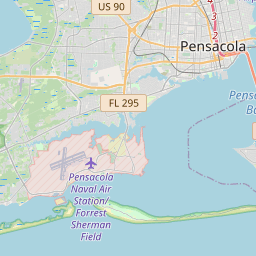Piers, Ports and Wharves: A Look At Pensacola's Waterfront
Historical marker location:
207 E Main St, Pensacola, Florida
( Marker is at the intersection of South Barracks Street and East Main Street, on the left when traveling south on South Barracks Street.)







© OpenStreetMap contributors
Florida Public Archaeology Network
More history nearby
Building at 101 North Riverview Street
NATIONAL REGISTER LISTING
0.07 mi.
Kucheman Building
NATIONAL REGISTER LISTING
0.09 mi.
Building at 126 South Riverview Street
NATIONAL REGISTER LISTING
0.1 mi.
Building at 306 South Second Street
NATIONAL REGISTER LISTING
0.14 mi.
Lock and Dam No. 12 Historic District
NATIONAL REGISTER LISTING
0.24 mi.
The Everglades, one of Florida's most iconic natural landmarks, was not always a protected area. In fact, it was once considered a worthless swamp and was drained and developed for agricultural purposes in the early 20th century.
About Escambia County
Escambia County Timeline
Escambia County, located in the Florida Panhandle, has a rich history that dates back thousands of years. The area was originally inhabited by Indigenous Peoples, including the Creek and Choctaw tribes. European contact began with Spanish explorers in the 16th century, most notably with the expedition led by Don Tristan de Luna in 1559. However, the Spanish struggled to maintain a presence in the region and abandoned their settlement in 1561.
Escambia County then came under British rule in the late 18th century as part of West Florida. During this time, the area experienced conflicts between the Native American tribes, the British, and colonists. In 1821, Florida became a United States territory and Escambia County was established as one of its original two counties. The county's boundaries have changed over time, but it has remained an important region in the state.
Throughout the 19th and early 20th centuries, Escambia County was heavily involved in industries such as timber and lumber, naval stores, and fishing. The city of Pensacola, which serves as the county seat, became an important naval base during World War II, and continues to be a significant military center. Today, Escambia County is known for its beautiful beaches, historic landmarks, and vibrant cultural heritage.
In recent years, the county has faced challenges such as natural disasters, including hurricanes, and environmental issues. However, efforts are being made to promote tourism, expand economic development, and preserve the area's natural resources and historical sites. Escambia County remains a dynamic region with a diverse population and a strong commitment to its past and future.
Escambia County then came under British rule in the late 18th century as part of West Florida. During this time, the area experienced conflicts between the Native American tribes, the British, and colonists. In 1821, Florida became a United States territory and Escambia County was established as one of its original two counties. The county's boundaries have changed over time, but it has remained an important region in the state.
Throughout the 19th and early 20th centuries, Escambia County was heavily involved in industries such as timber and lumber, naval stores, and fishing. The city of Pensacola, which serves as the county seat, became an important naval base during World War II, and continues to be a significant military center. Today, Escambia County is known for its beautiful beaches, historic landmarks, and vibrant cultural heritage.
In recent years, the county has faced challenges such as natural disasters, including hurricanes, and environmental issues. However, efforts are being made to promote tourism, expand economic development, and preserve the area's natural resources and historical sites. Escambia County remains a dynamic region with a diverse population and a strong commitment to its past and future.
Escambia County Timeline
This timeline provides a condensed summary of the historical journey of Escambia County, Florida.
- 1559: Spanish explorer Don Tristan de Luna establishes the first European settlement, known as Panzacola, in what is now Pensacola, Florida.
- 1698: Spanish forces construct Fort San Carlos de Austria to protect Pensacola.
- 1763: Treaties of Paris and Fountainbleau transfer the area from Spain to Great Britain.
- 1781: Spanish forces regain control of Pensacola during the American Revolutionary War.
- 1821: Florida becomes a United States territory, and Pensacola becomes the county seat of Escambia County.
- 1825: Pensacola becomes an official port of entry.
- 1838: The county seat is relocated from Pensacola to Milton.
- 1861: Escambia County secedes from the Union and joins the Confederate States of America.
- 1868: The county seat is returned to Pensacola.
- 1921: The Perdido Key Bridge is completed, connecting Escambia County to Alabama.
- 1940: The Pensacola Naval Air Station is established.
- 1968: Hurricane Opal devastates the area, causing significant damage and loss of life.
- 2004: Hurricane Ivan makes landfall in Escambia County, causing severe destruction to homes and infrastructure.